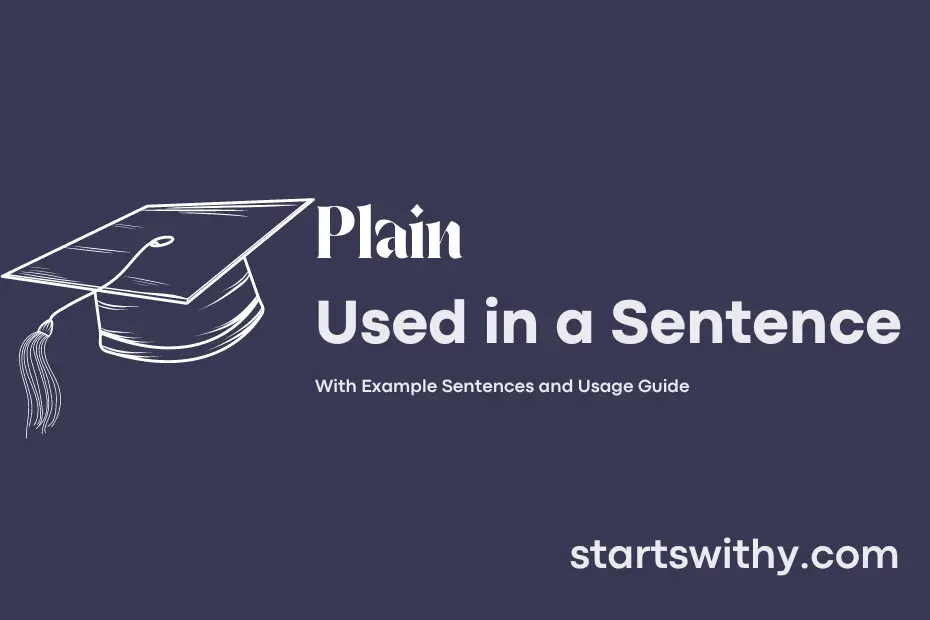When we refer to a “Plain” example sentence, we specifically mean a straightforward and uncomplicated statement that is used to illustrate a point or concept. These sentences lack embellishments or complexity, serving as clear and basic examples for better understanding.
In language and writing, “Plain” example sentences are valuable tools for demonstrating grammar rules, vocabulary usage, or sentence structure in a simple and accessible manner. Utilizing plain examples can help clarify explanations and make learning more effective for readers of all levels.
7 Examples Of Plain Used In a Sentence For Kids
- The sky is plain blue today.
- I like to eat plain rice with dal.
- My shirt is plain white in color.
- The wall is plain without any decorations.
- Can you draw a plain circle for me?
- Shepards wear plain clothes to work.
- Let’s color this butterfly with plain colors.
14 Sentences with Plain Examples
- Plain dosa with chutney is a common choice for breakfast in South India.
- It’s important to use plain language when writing academic essays to ensure clarity.
- For a quick snack, you can’t go wrong with a plain samosa from the canteen.
- Understanding the plain meaning of a text is essential for literature students.
- It’s always a good idea to have a plain notebook handy for taking notes during lectures.
- A plain white shirt is a versatile wardrobe staple for college presentations.
- Sometimes, a plain black coffee is all you need to stay awake during late-night study sessions.
- Adding a plain salad to your meal can help balance out a heavy college cafeteria lunch.
- Opting for a plain pen instead of a fancy one can help you stay focused while taking exams.
- A plain pair of jeans and a T-shirt is the go-to outfit for many college students.
- Keeping your room plain and clutter-free can help create a conducive environment for studying.
- During exams, it’s best to stick to a plain revision schedule to avoid feeling overwhelmed.
- A plain glass of water can do wonders in keeping you hydrated throughout the day.
- Using plain PowerPoint slides with minimal text is recommended for effective presentations.
How To Use Plain in Sentences?
Plain can be used in a sentence as an adjective to describe something simple, straightforward, or without any extra decoration. For example, “She preferred plain yogurt over flavored ones.” In this sentence, plain is used to indicate the type of yogurt without any added flavors or toppings.
To use plain effectively in a sentence, remember to place it before the noun it is describing. For instance, “He wore a plain white shirt to the party.” In this case, plain is placed before the noun “white shirt” to describe its simplicity.
Another way to use plain is to pair it with adverbs like “very” or “quite” to emphasize the degree of simplicity. For example, “The room was very plain with minimal furniture.” Here, the adverb “very” is used to highlight the extent of the plainness of the room.
It’s important to note that plain is a versatile word that can be used in various contexts to describe different characteristics such as simplicity, clarity, or lack of embellishment. By practicing using plain in different sentences, you can improve your vocabulary and communication skills.
Conclusion
In writing, sentences with plain language are straightforward and easily understood by a wide range of readers. By avoiding complexity and using clear, simple words, authors can effectively communicate their message without causing confusion. The use of plain sentences enhances the accessibility of information, making it more digestible for individuals with varying levels of literacy and language proficiency.
Overall, incorporating sentences with plain language is essential for effective communication across different audiences. Whether in literature, academic writing, or professional documents, the use of simple and direct sentences can improve comprehension and ensure that the intended message is received as intended. By prioritizing clarity and accessibility, writers can connect more effectively with their readers and convey their ideas in a more impactful manner.



